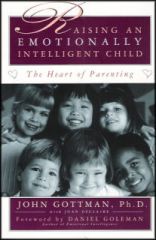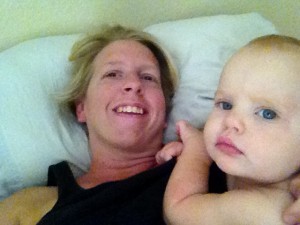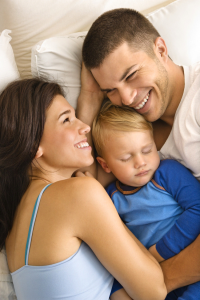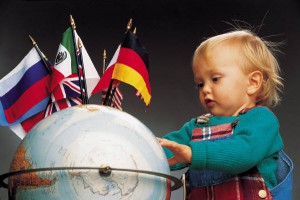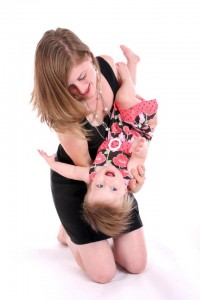This AP Month Blog Event post was submitted by reader Elizabeth Wickoren, who blogs at Mothering from the Maelstrom.
Each year we try to celebrate the 12 days of Christmas and not just Christmas Day itself. Makes for a somewhat less frantic early December when you don’t feel like you have to cram a year’s worth of joy and Christmasy-ness into two days. We’ve been doing a lot of yummy Christmas baking the last few days, socking away a little bit of each batch in the freezer for our Twelfth Night party, but mostly just gobbling it down as fast as we make it. We’re also making time for lots of the things we really love, like board games, feeding the wildlife, thrift store shopping, movies, video games, theater and today, ART.
Art is one thing I feel like I really don’t do enough of with the kids. I am a big old scrooge when it comes to any art other than drawing, really. The thought of clay, paint and the like just makes me cringe. All that mess and chaos … ugh! Don’t get me wrong, I love to do art myself. I LOVE it, love love LOVE it. But I tend to be kind of lazy when it comes to breaking out the messy stuff for my brood. Or I thought it was laziness. Today I’m thinking it is more like a self-preservation instinct.
I was reading a Deep Space Sparkle article describing a lovely winter trees project involving shaving cream, and thinking, “I bet the kids would get a big kick out of shaving cream.” So, figuring it was the season for fun things, I got a couple of cans of shaving cream and cleared off the kitchen table.
Things started out innocently enough …

They were swirling colors and dipping papers …
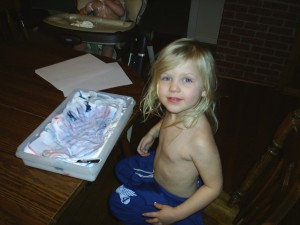
Even the baby got to participate …
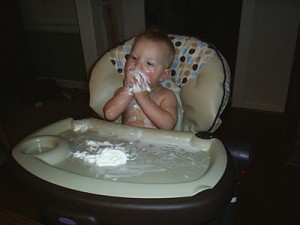
Don’t worry, hers is whipped cream, not shaving cream.
If you want a fun blog post to inspire you to art projects of your own, stop reading now. Get some cans of shaving cream and have fun. If you want to hear our horror story, however, read on.
At this point things took a turn for the worst. Mitchell was really enjoying the shaving cream. Enjoying it so much that he started rubbing it all over his stomach. I sent him to go clean up a bit, and while I was getting him to clean up, the other two decided to follow suit and start spreading shaving cream all over their bodies. So I sent them to the bathroom.
While they were cleaning up, Mitchell decided to stir his shaving cream as fast as he could so all the colors mixed into a really putrid olive green. So much for lovely swirls. Then the little two came back from the bathroom, and Henry decided to make his a solid-greeny mush, too.
I started to get a bit irritated that they were ignoring the whole concept of making beautiful art and instead were just focusing on the smoosh factor. I tried not to let it get to me. Intellectually, I KNEW that boys will be boys and that they were having a great, fun, tactile experience even if they weren’t making art as I had planned. I praised Violet’s lovely swirls because they really were lovely, and the boys ended up asking me to help them have swirls, too, so we added more color to their green shaving cream. In the end, I was a bit frazzled, but everyone had fun and had some swirly art.
Now, we could end the story there, but as you may have noticed, this last section didn’t have pictures to go with it. My hands were full of shaving cream, and I was just too crabby to take any pictures of the green goo.
There also aren’t any pictures to go with this next section.
Once everyone had made several swirly art pictures and I was sufficiently out of patience, I started to get things cleaned up. While my back was turned, setting pictures out to dry … Violet started rubbing shaving cream on her tummy, and the boys started to dive into the shaving cream up to their elbows. Their laughter started getting that crazy sound to it. You know, when it starts to shift from joyful, delightful giggling to insane, overstimulated, maniacal laughter. Plops of shaving cream started landing on the floor, on the chairs, on clothes. Things were officially out of hand.
I will admit, this was not my finest moment. I yelled a bit. Tossed out some choice phrases that had no business being said to children. Maybe “yelled a bit” is being too kind. I screamed. I really lost it. All I could think was that I had spent all this effort trying to do something fun and special with them, and they were almost literally throwing it in my face. Mitchell, especially, got the brunt of it because he is the oldest and “should know better” and his innovative little brain started all the mischief. Everyone except the baby got sent to bathrooms.
The baby was wondering what the HECK all the fuss was about. But another round of whipped cream stopped her wondering, and she got back to business.
As the baby was getting round #2 of whipped cream, shenanigans started breaking out in the various sinks. Thankfully, at that moment, Daddy walked in the door before I could strangle anyone. He bustled the little kids off to the bathtub for a thorough cleaning. Mitch was sitting in Grandma’s bathroom where I had exiled him, and I was left with a table to wipe up and a moment to catch my breath.
After a few deep breaths, I went in to talk to Mitchell. I apologized for screaming and told him I shouldn’t have said the things I said. Then we talked together about where things went wrong. I asked him if he were at school, would he have taken the art supplies and started rubbing them all over his body? He laughed and said, “No!” I explained that I was angry that they had misused the art supplies like that for me. And he said, “But the shaving cream just feels so good!”
I started telling him how there is a time and a place for whole-body art. And the time and place is outside in the summer, where they can be hosed off afterwards and not wreck any hardwood floor finishes or anything. Then I had a light bulb go off. “The other place for whole-body art,” I said, “is in the bathtub. Where all the mess can be rinsed down the drain. Hop in.”
So Mitch continued his art exploration, and I went to bathe the baby.

Bathing the baby always cheers me up. And Fergie (our dog) helped with the clean-up.
So, what is the moral of this story? The moral is, I need to approach art with no expectations except mess. Expecting any kind of aesthetically pleasing results is just setting myself up for disappointment and stress. I mean, the whole point of art, in my opinion, is to enjoy the process and not worry too much about the end result. I kind of lost that as I gazed at the Deep Space Sparkle pictures of magical, snowy trees and imagined that we, too, could make something so preciously cute. The kids didn’t lose sight of the purpose, though. Their entire aim was to enjoy the process, so kudos to them. And I apologize for raining on their parade.
Underestimating the amount of mess that can be made with two cans of shaving cream was a grave error in judgment on my part. Frankly, I think all art should be done in the bathtub in the future. It’s really the perfect location. Actually, we have an unfinished room in the basement, with a drain in the floor. Shall we tile that sucker up for a whole-body art studio? A very tempting idea, actually …
And today, as I reflected on what I could have done differently, another factor popped into my mind. I had forgotten that the day before had been Mitchell’s birthday. We had promised him that a special ADHD diet didn’t mean he could NEVER have the food he liked again. We said on his birthday he could eat anything he wanted. And boy he did. We had McDonalds, pizza, donuts, the works!
The thing about Mitchell’s food sensitivities is that they generally don’t affect him until the next day. It’s not an immediate thing. So planning a messy art project the day after he stuffed his face with preservatives, gluten, dyes, milk and high fructose corn syrup was just asking for trouble. So–note to self–don’t try to do ANYTHING the day after Mitch has blown his diet except manage his symptoms.
So, while it wasn’t one of my finest moments, I think yesterday was not without merit. Everyone got bathed, swirly art DID get made and mama learned (and relearned) a few lessons.



